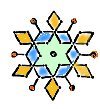Article by Dr. Jyotsna Kamat
Pictures by Dr. Krishnanand Kamat
Page Last Updated: December 07, 2024
Rangoli (ran-goal-i, also known as Alpana, Kolam and by other names) is a traditional art of decorating courtyards and walls of Indian houses, places of worship and sometimes eating places as well. The powder of white stone, lime, rice flour and other cheap paste is used to draw intricate and ritual designs. Each state of India has its own way of painting Rangoli.
One characteristic of Rangoli is that it is painted by commoners. On some special occasions it is painted in every home, with or without formal training in Rangoli art. The art is typically transferred from generation to generation and from friend to friend. Popular magazines publish new designs of Rangoli every week and on special occasions there are Rangoli contests.

Girl painting Rangoli
Women use their bare fingers or a brush to create various designs from sandstone powder or grain-flour. Sometimes colors and petals are used in addition to flour paste. Some women are so skilled with their fingers that they can create figures of deities, chariots, temples, etc., on the finely layered floor. Petals of various flowers, such as oleanders, cosmos, zenia, chrysanthemums, and green leaves provide the artist the ability to work out various patterns and colors. In the evenings of festive occasions, when oil lamps are lit, and the atmosphere is cool and pleasant, such floral designs create the atmosphere of a well-planned divine garden. This Rangoli garden surrounds the sacred spot where pooja (prayer) is performed or a child is seated for his or her birthday, naming ceremony or thread ceremony. Newly-weds also receive guests in such decorated surroundings when the wedding celebrations are ongoing.
Most of the Rangoli designs are motifs of plants, flowers, leaves such as coconut, lotus, mango, and ashwath (peepal leaf), the animals such as cows, elephants, and horses, and the birds like eagles and swans. There are geometrical designs as well. When drawn with fingers, these acquire different dimensions on their own.
Girls and wives compete with each other to draw a new design every time, even when there are no prizes to be given. They believe that the gods are fond of cleanliness and things of beauty, and this is one household art meant for propitiating deities.
![]()
*title inspired by Stephen Huyler's book on the same topic.
See Also:
- Index of Rangoli designs at Kamat's Potpourri
- Animation showing step-by-step procedure for a sample design
- How to join simple patterns for complex designs
- Hundreds of Rangoli Designs in Kamat PictureSearch
|
|
|
|
|
Kamat's Potpourri ![]() Timeless
Theater
Timeless
Theater ![]() Arts of India _LArrow
Folk Arts
Arts of India _LArrow
Folk Arts
